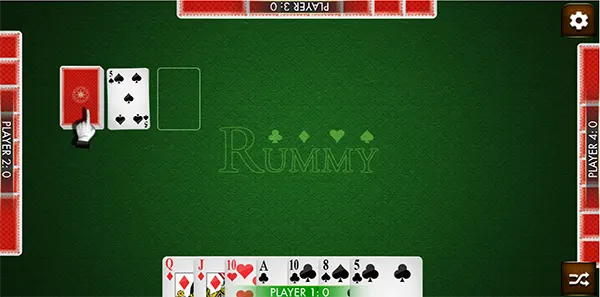We take a look at how basic rummy is played, how it is dealt as well as the basic scoring and why players enjoy playing it so much.
Basic Rummy
Rummy in it’s basic form is played with two, four or even up to six players. The game may be payed on a fixed number of deals or alternatively played to a target score, both of which should be agreed upon by the players prior to the start of the game.
Standard Card Deck
Basic Rummy is played with one standard deck of 52 cards. In the case of two players, each player will receive Ten cards. For three or four players, each player will be dealt Seven cards, and for five to six players each player will be dealt Six Cards. The cards are dealt one at a time and are dealt in a clockwise direction. After each game, the next player in the clockwise direction will deal. After all players have received their respective amount of cards, one card will be placed face up (to form the discard pile) and the balance of the cards next to that one card face down (to form the Stock).
Each player in turn will be required to begin play by taking one card from either the top of the Stock pile or the top card on the discard pile, and adding it to their hand. The discard pile is face up, so you can see in advance what you are getting. The stock is face down, so if you choose to draw from the stock you do not see the card until after you have committed yourself to take it. If you draw from the stock pile, you add the card to your hand without showing it to the other players.

The object of Rummy is to dispose of all the cards in your hand by one or all three of the following methods:-
The Meld
Melding: This is to take a combination of cards from your hand and place it face up in front of you. This combination can be done in two ways which is in sequences of run such as three or more cards of the same suit in consecutive order, or as a group where three or four cards are of the same rank.
Laying Off
Laying off is a term that is by adding a card/cards from your hand to an existing meld on the table. These cards must be added to a valid meld, and the player is not permitted to rearrange the meld in the process. An example of this would be as follow. Let’s say an opponent melded 3 aces in a previous turn. If you have an ace, during your next turn you would lay off your ace to go with your opponents 3 aces.
Discarding
Discarding simply means you place a card from your hand on top of the discard pile. As the game requires you to pick one card at the start of your hand, it also requires you to discard one card to complete your hand.
When you discard the last card in your hand, it is determined you have “gone out”. As soon as someone goes out, play ceases. There can be no further melding or laying off, even if the other players have valid combinations in their hands.
What if the Stock Pile of Cards Runs Out
If the stock pile has run out and the next player does not want to take the discard, the discard pile is turned over, without shuffling, to form a new stock, and play continues.
Determining the Score
When a player goes out, all the other players add up the value of all their cards still remaining in their hands, as follows:
- Face cards (K,Q,J) are worth 10 points each
- Aces are worth 1 point each
- Number Cards are worth their individual face value
The total value of all the cards in the hands of the other players is added to the winner’s cumulative score.
Basic Rummy Number of Hands
The game continues with further deals until a player reaches the points target that was decided before the game began, or until the agreed number of deals have been played.